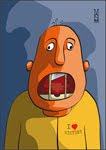The Magic of Things: Still Life Painting 1500–1800
The Stadel Museum in Frankfurt presents the exhibit The Magic of Things: Still Life Painting 1500–1800 through August 17. Dewdrops on dainty petals, light glancing off glass drinking goblets and precious silver dishes, candied sweetmeats in blue-and-white porcelain bowls from China, the delicate fluff of a peach, the pallor of a skull... To this day, still lifes captivate us with their close-up views of objects no longer living but far from lifeless, reproduced with painterly finesse and subtle colouration. However, still life painting was anything but a purely aesthetic matter, even if the present-day viewer tends to perceive it as such. The exhibition “The Magic of Things. Still Life Painting 1500–1800” is designed to convey both aspects – the genre’s aesthetic pleasure as well as its contemporary context with regard to meaning and function.
Pieter Aertsen (1507/08 - 1575), Market Piece with Christ and the Adulteress, 1559
Oil on oakwood, 122.5 x 180.5 cm. Inscribed left on barrel “P A / 1559”.
(between P and A a trident; only upper triangle of “A”)
Städel Museum, Frankfurt am Main
Photo: Artothek
With more than ninety masterworks, the show spreads out a panorama of the still life’s development in the Netherlands and Germany from its beginnings in the late fifteenth century to the end of the eighteenth century. To this end, it unites the superb holdings of the Städel Museum in Frankfurt, the Hessisches Landesmuseum Darmstadt and the Kunstmuseum Basel, enhanced by a number of selected loans from other collections, public and private.
After its liberation from the religious painting of the late Middle Ages, the still life initially served as a means of recording and interpreting the stationary objects found in the viewer’s everyday surroundings, objects in which the order and structure of the abstract world of the Baroque could be mirrored: for example the individual’s senses and “humours”, the elements or seasons which shaped and moulded his environment, or the mortality of mankind in general and man’s longing for redemption from sin. Due to its concentration on a small number of consistently recurring objects, however, the late Baroque still life also served as an ideal experimental laboratory for means of artistic expression. The still life ranked low in the hierarchy of genres, and to attain success its practitioners had to use it to demonstrate their special artistic abilities: a work owed its charm and value to its composition, the meaningful combination of objects and the skilful brushstroke. As a result, the paintings bear witness to mastery in the wonderful rendition of various surfaces.
Willem van Aelst
Fish on a Tin Plate and Two Glasses, 1679
Retracing the evolution of still life painting from 1500 to 1800, while also acquainting the visitor with the most important pictorial motifs and types, the show begins with the forerunners to the still life produced in the period marking the transition from the Middle Ages to the Early Modern era. The first section thus illustrates the process of the still life’s emancipation from its role as a symbolically charged accessory of religious painting to a pictorial theme in its own right.
The subsequent section is devoted to the early autonomous still life of around 1600 with Jan Brueghel and Georg Flegel as its chief exponents. Here the superb selection of splendid works already constitutes one of the exhibition’s highlights.
Following the cartouche paintings, banquet pieces and vanitas still lifes make up the next group of works, introducing viewers to the symbolism of Baroque imagery and its highly idiosyncratic blend of sensual stimulation and admonitions regarding the transience of earthly existence.
By contrast, the following department on fish and hunting still lifes exemplifies the considerable extent to which seventeenth-century painters specialized in certain genres as a means of gaining a competitive edge on the art market: often one artist in a given city would virtually hold a monopoly on a certain type of composition. The “sumptuous still life”, for its part, – represented above all by the names Jan Davidsz. de Heem and Willem van Aelst, with several works by each of them on view – was entirely dedicated to the description of luxuriance as well as the demonstration of fine-painterly virtuosity.
The final chapter of the show explores the eighteenth century, which lends particularly apt expression to the theme of the “magic of things” in the paintings of Justus Juncker – an artist who elevates a pear, for example, to imposing monumentality by enlarging it and placing it on a pedestal. Jean Siméon Chardin’s Städel painting “Still Life with Partridge and Pear” employs no more than a few laconic brushstrokes to endow those objects with astonishing presence, bringing the exhibition to its magnificent conclusion.





No comments:
Post a Comment